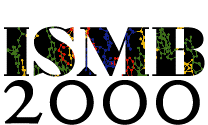80 -
Constructing Sequence Domains for Protein Structural Genomics Target Selection
Gulriz Aytekin-Kurban, Terry Gaasterland, The Rockefeller University
We seek to select structural genomics targets to maximize information gained from each structure and minimize total structures solved. Partitioning and clustering protein subsequences using pairwise local alignments yields sequence domains for proteins from 40 genomes. We compare domain clusters with CATH structure domains and select representative sequences for determination.
81 - Genia: A System Facilitating
the Search for Therapeutic Targets
Maura Cárdenas-García, Jaime Lagúnez-Otero, Instituto de Quimica UNAM Ciudad Universitaria
We present recent progress with Genia: an expert system that has Ras signal transduction pathways. Ras is a key protein in the amplification of the signal induced by the growth factors. It is an oncoprotein associated with different types of cancer.
82 - Target Selection for Staph and Strep Structural Genomics
Lynda Ellis, Paul Tavernier, Edward Bryan, Doug Ohlendorf, University of Minnesota
We describe the target selection protocol for a structural genomics project (SSSG) developed around the soon-to-be completed genomes of S. aureus and S. pyogenes. Project results are available on the SSSG Website. http://strep.ahc.umn.edu
83 - A Computational Screen for Novel Targets of Sno-like RNA's in Pyrococcus
Steven Johnson, Sean R. Eddy, Washington University
C/D box small nucleolar RNAs (snoRNAs) contain antisense, or guide, sequences that direct the methylation of rRNA. Several "orphan" snoRNAs have been identified that possess poor complementarity to rRNA. These snoRNAs may be modifying novel targets. We are performing a computational screen for candidate novel snoRNA targets in the Archaea.
84 - Computational Screening Studies for Core Binding Factor Beta: Use of Multiple Conformations to Model Receptor Flexibility
Ryan Lilien, Mohini Sridharan, Xumei Huang, John Bushweller, Bruce Donald, Dartmouth College
We present a computer-aided drug design approach allowing protein flexibility. An ensemble of low-energy conformations of CBF-beta (from solution NMR) is screened against a database of 70,000 liquids. LUDI (Bohm, 1996) is used for each run and the top binding liquids were consolidated and screened by NMR and gel-shift assays.
85 - Structure-specificity Relationship and Target Prediction of Transcription Factors
A. Sarai, S. Selvaraj, P. Prabakaran, RIKEN Life Science Center, Japan; H. Kono, University of Pennsylvania
We show that we can quantify the specificity in the protein-DNA recognition by the statistical analysis of structural data of protein-DNA complex. We derived empirical potential functions for the specific base-amino acid interactions, and examined the relationship between structure and specificity. We also discuss target prediction of transcription factors at the genome level.
86 - A Novel System for the Identification of Potential Target Epitopes and Molecular Mimics for T Cell Receptor
Yingdong Zhao, National Institutes of Health; Bruno Gran, National Institute of Neurological Disorder; Clemencia Pinilla, Torrey Pines Institute for Molecular Studies; Bernhard Hemmer, Silva Markovic-Plese, Roland Martin, National Institute of Neurological Disorder; Richard Simon, National Institutes of Health
Combining mathematical models with combinatorial peptide library data, we developed a novel approach for the identification of T cell epitope and its molecular mimics by extensive database searches and neural network. This approach has been tested to be very efficient and accurate in several known/unknown CD4+ and CD8+ systems.


